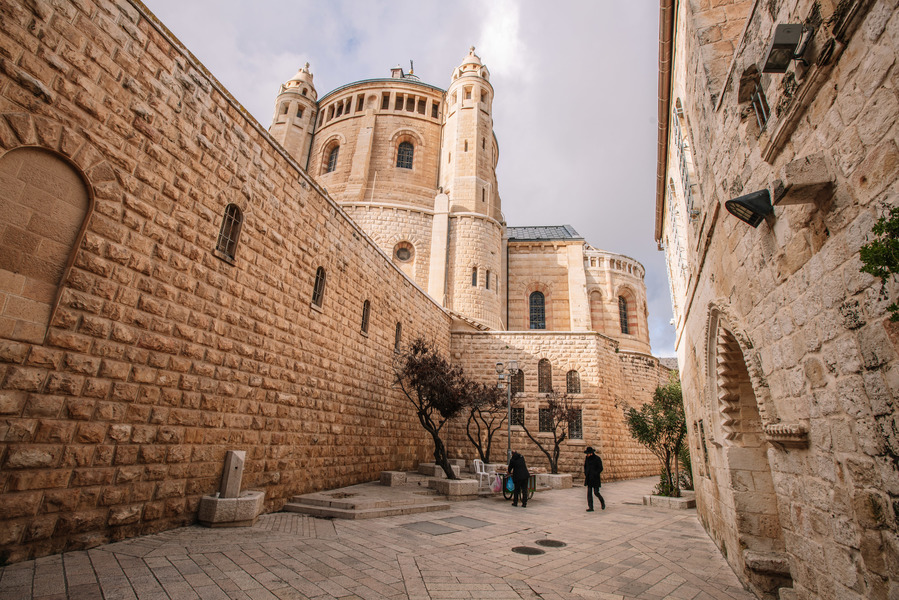Churches in Israel
For many Christians, a trip to Israel is the visit of a lifetime - an opportunity to walk in the footsteps of Jesus, exploring his birthplace, early and formative years, and retrace his last walk to Calvary in Jerusalem. Without a doubt, this is a very emotional and rewarding experience. Israel is home to countless churches, some ‘must-see’ sites and others less well-known. Dotted all across the country, they contain mosaics and artifacts often dating back thousands of years, which makes them fascinating not just from a religious but also a historical viewpoint. Let’s take a look at some of the many wonderful churches you’re likely to come across on various Christian day tours in Israel

Church of All Nations, Mount of Olives, Jerusalem. Photo credit: © Shutterstock
JERUSALEM CHURCHES
1. Jerusalem Old City and Mount Zion
- Church of the Holy Sepulchre - Built on the spot where Christ was crucified, buried, and resurrected, this extraordinary and enormous church is filled with shrines, works of art, and small altars and chapels. Consecrated in 335 CE, it is the most visited and famous church in Jerusalem, if not Israel and its enormous interior can hold up to eight thousand people.
- Church of St. Anne - Close to the Lion’s Gate, this church was built during Crusaders' times and sits on the ruins of a Byzantine church. The basilica has three aisles and boasts cross-vaulted ceilings and pillars and a simple interior.
- Cathedral of Saint James - This ornately designed building in the Armenian Quarter is one of the few Crusader-era churches to remain intact.
- Dormition Abbey - easily recognizable, due to its round (not rectangular) shape, this monastic church was built by German Emperor Wilhelm II and has a beautiful mosaic floor.
- Church of Saint Alexander Nevsky - this Russian Orthodox Church is built over the remains of what historians believe was the ‘Judgment Gate’ where Jesus passed on his way to Golgotha.
For a complete list of Jerusalem’s Old City churches, take a look at this article. You can also join one of multiple Jerusalem tours to explore the Jerusalem central churches.

Dormition Abbey. Photo credit: © Dmitry Mishin
2. Jerusalem - Mount of Olives
- Church of All Nations - this impressive church’s facade features Corinthian columns under a mosaic portraying Jesus and is thought to be the place he prayed before his arrest by the Romans.
- Pater Noster - the highlight of this Carmelite Monastery is the decorated ceramic tiles, spelling out the Lord’s Prayer in a wide variety of scripts and languages.
- Dominus Flevit - the Italian architect Barluzzi designed this beautiful church in the shape of a teardrop, and its famous window frames a view of the Old City behind it.
- Church of Mary Magdalene - this distinctive Russian Orthodox Church was constructed in 1886 and, in traditional style, has seven gilded onion domes. It has a visually stunning interior with many icons and the gardens are beautifully kept.
- Russian Orthodox Convent and Church of the Ascension - this is supposedly the site where Jesus ascended to heaven, 40 days after his resurrection, and boasts an impressive bell tower.
To see the full list of churches on the Mount of Olives, click here. Try this 2-day Christian Jerusalem tour to see most of the above-mentioned churches as well as the Garden of Gethsemane and The Pools of Bethesda.

Pater Noster Church, Jerusalem. Photo credit: © Shutterstock
3. Jerusalem’s Ein Kerem Churches
- Church of the Visitation - this Franciscan church is named after Mary’s visit to the summer house of the parents of John the Baptist and the blue mosaic on the exterior illustrates this.
- Convent of the Sisters of Zion - this beautiful Catholic nunnery was founded by converted Jew Marie-Alphonse Ratisbonne and houses a guesthouse and library. Underneath is a large water pool that dates back to Second Temple times, as well as a number of Roman flagstones.
- Gorny or "Moscobia" Convent - this Russian monastery consists of several small churches and was founded as an attempt to ‘mark territory’. Today it is inhabited by 48 nuns.
- Church of Nativity of John the Baptist - designed by Italian architect Barluzzi, this Catholic church dates back to Crusader times and is easily identifiable because of its tall tower and round spire. It also boasts a grotto which is supposed to have been the birthplace of John.
- St John In The Wilderness - this Franciscan monastery was built on Byzantine ruins and sits next to a spring in a wooded area. It commemorates the early years of John the Baptist.
To see Ein Kerem churches join one of Jerusalem Private tours.

Convent of the Sisters of Zion, Ein Kerem. Photo credit: © Shutterstock
CHURCHES IN NORTHERN ISRAEL
1. Nazareth Churches
- The Church of the Annunciation - built on the spot where the Virgin Mary was visited by the Angel Gabriel, this church’s breathtaking basilica is 50 meters high and its colorful mosaics depict the Holy Family.
- Church of Saint Joseph - according to legend, this church was built over the carpentry workshop of Jesus’ father, Joseph.
- Christ Church, Nazareth - built in 1871 and shaped like a cross, this Anglican church was the second of its kind in the Holy Land.
- Coptic Church of the Annunciation - this Greek Orthodox church was built in 1750 and stands over the ruins of a 12th century Crusader church, destroyed by the Mamluks.
- Greek Catholic Church of Nazareth - this Byzantine Catholic church was built in the early 20th century by Archbishop Hakim Maksymosa.
- Greek Orthodox Church of the Annunciation - also known as the Greek Orthodox Church of Saint Gabriel, this medieval church’s underground chapel contains a spring.
- Synagogue Church - tradition has it that this small church is the same building that used to be the village synagogue in the time of Jesus. Above the doorway is a sign stating ‘the synagogue.”
For more about churches in Nazareth, click here. To visit the main Nazareth churches join a day Nazareth Tour.

Church of Saint Joseph, Nazareth. Photo credit: © Shutterstock
2. The Galilee Churches
- Multiplication Church, Tabgha - this Roman Catholic church is overseen by the Benedictine Order and is the spot at which Jesus performed his miracle with loaves and fishes.
- Church of the Primacy of Saint Peter, Tabgha - this Franciscan church is the spot at which Jesus appeared to his disciples after his resurrection and commissioned Peter as leader of his church.
- Wedding Church, Cana - this Franciscan church is the place at which Jesus performed his miracle of turning water into wine, at a poor couple’s wedding.
- Church of the Transfiguration - located at Mount Tabor and built by Franciscans in 1924, this large church is the spot at which Jesus was transfigured in the presence of Peter, John, and James.
- Mount Beatitudes Church - situated on Mount Eremos, this Roman Catholic Franciscan chapel has a marble veneer and gold mosaic in its dome.
- Church of St. Andrew, Old City of Acre - this Crusader-era church contains a gothic marble portal, brought to Acre as a war trophy. Built in 1765, it is ornately decorated and houses many icons.
- Naim Church - this Franciscan church is located near Mount Tabor in a Galilee village where Jesus is thought to have brought back to life a widow’s son.
- The Pilgrimage Church of St. Peter - this modern catholic church is located in Capernaum, where both Jesus and his first disciple, Peter, lived.
For more information about churches in Galilee, click here. Churches of Acre built by Crusaders are described in this article. If you are interested in visiting some of the churches join a Christian Galilee tour.
Multiplication Church, Tabgha. Photo credit: © Shutterstock
3. Haifa Churches
- St. Elijah Cathedral - serving the Greek Catholics of Haifa, this cathedral was designed by architect Sammihorn Atallah. Its front is covered with a cross and a few meters away is a small bell tower.
- St. Louis the King Cathedral - founded in 1889, this church serves as the headquarters of the Maronite Catholics in Israel and was dedicated to King Louis IX.
- Muhraka Monastery - this Monastery sits on Mount Carmel, which is said to have been the traditional home of Elijah the Prophet. It boasts incredible views of the surrounding area.
- Sacred Heart Chapel, Haifa - this Catholic church is located on Mount Carmel and is known for its unique design (it was once a windmill) with spectacular views over the Mediterranean.
- St. Joseph's Church, Haifa - Designed by Italian architect Antonio Barluzzi, this Carmelite church was inaugurated in 1961 and is the last building Barluzzi designed in the Holy Land.
- Stella Maris Monastery - Latin for ‘Star of the Sea’ this Carmelite church dates back to 1631 and its nearby monastery once served as a hospital for the soldiers of Napoleon.
To tour Haifa churches don't hesitate to join Haifa and the Carmel Private Tour.

Seaview, Haifa. Photo credit: © Shutterstock
CHURCHES IN CENTRAL ISRAEL
1. Churches in Tel Aviv
- St. Anthony's Church - completed in 1932, this Catholic church is built in Gothic Revival style and was named in honor of St. Anthony of Padua, a priest of the Franciscan Order.
- Immanuel Church - this Lutheran church was established in 1904 for the German Evangelicals of the area and sits in the German-American colony area of Tel Aviv. Today Protestants and a community of Messianic Jews worship here.
- Saint Nicholas Monastery - this Armenian monastery sits in the Old City of Jaffa, close to the harbor, and was founded before 1000 CE in the name of St. Nicholas, the patron saint of sailors.
- St. Peter's Church - built in 1654 and dedicated to Saint Peter, over a medieval citadel, the building was twice destroyed and rebuilt. It has a tall, brick façade and towering bell tower and is a distinctive building in Jaffa.
If you would like to visit Tel Aviv churches, join a Tel Aviv and Old Jaffa Private Tour.

St. Peter's Church, Jaffa. Photo credit: © Dmitry Mishin
2. Churches Outside Jerusalem
- The Latrun Trappist Monastery - established in 1890, by Trappist monks, many of whom believe that language is sacred and have therefore taken vows of silence, this monastery also boasts a vineyard. Today it produces a number of excellent wines and liquors that are sold in the Abbey shop.
- Beit Jamal Monastery - Meaning ‘ the House of the Camel’ is a Catholic monastery run by Salesian priests. Close by is a small church built in 1930 on the ruins of a 5th-century Byzantine church discovered on the site.
- Benedictine monastery in Abu Ghosh - Run by the Olivetan Benedictine Order, this church is built on the foundations of a Crusader Church of the Resurrection, established in the 12th century on top of Roman ruins. There is a fountain that flows out from a crypt below and twice a year the church - along with the nearby Notre-Dame de l’Arche church - hosts a prominent classical and choral music festival.

The Latrun Trappist Monastery. Photo credit: © Dmitry Mishin
CHURCHES IN THE WEST BANK
- Church of the Nativity, Bethlehem - originally commissioned by Emperor Constantine the Great, this basilica contains a grotto which is of great significance to Christians since they believe it to be the birthplace of Jesus. It is the oldest continuously-used grotto used for worship in Christianity. The basilica itself is the oldest of its kind in the Holy Land.
- Church of St. Catherine, Bethlehem - affiliated with the Catholic Church and Latin Patriarchate of Jerusalem, it also functions as a Franciscan monastery. There is a complex of caves under the building and it is part of UNESCO’s World Heritage List, under the title of “Birthplace of Jesus, Church of the Nativity''.
- Chapel of Shepherd's Field, Bethlehem - this Roman Catholic church marks the place where, according to tradition, angels first announced the birth of Christ. Built by the Franciscans in 1953, it was designed by architect Antonio Barluzzi and has five apses, which symbolize the outline of a nomadic tent.
- Chapel of the Milk Grotto, Bethlehem - carved out of soft white rock, this is a sacred site both for Christian and Muslim pilgrims and is popular with new mothers and women who are trying to become pregnant. According to tradition, Mary and Joseph stopped here and as Mary nursed baby Jesus, a drop of her milk fell upon the stone and it turned white.
- Mar Saba Monastery - this Greek Orthodox monastery was founded in 483 by Sabbas the Sanctified and is considered to be one of the world’s oldest inhabited monasteries (today it houses around 20 monks). One of its famous ancient traditions is its refusal to allow entrance to women.
- Monastery of Saints John and George of Choziba - located in Wadi Qelt, this extraordinary monastery literally hangs off a cliff. It dates back to around 500 CE and can only be reached by a pedestrian bridge. Traditionally, the area is associated with the Prophet Elijah and holds the relics of three Eastern Orthodox saints, which means it is very popular with pilgrims.
- Monastery of the Temptation, Jericho - located on a cliff, this is the place where Jesus spent 40 days and nights successfully resisting the temptations that Satan placed before him.
To visit churches in the West Bank join one of the West Bank tours.

Church of the Nativity, Bethlehem. Photo credit: © Shutterstock
 Login / Register
Login / Register
 Contact Us
Contact Us

 Certificate of Excellence
Certificate of Excellence Guaranteed Departure
Guaranteed Departure Low Prices Guaranteed
Low Prices Guaranteed 24/7 Support
24/7 Support




